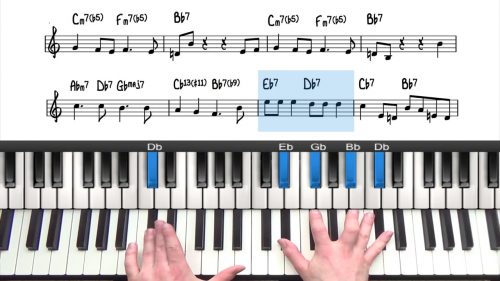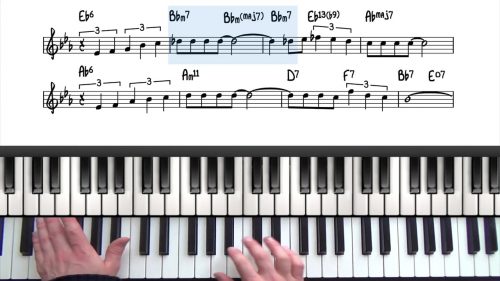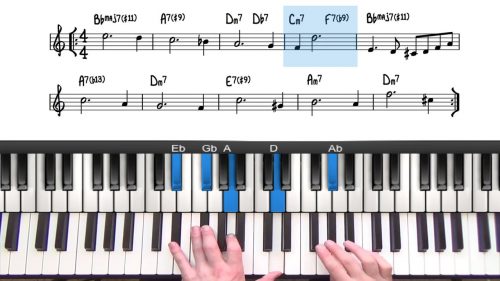Laura Jazz Piano Tutorial Lesson
In this lesson we create a ballad arrangement for the jazz standard ‘Laura’.
The tune is written in the key of C Major and it has a strong impressionist influence with frequent modulations and a wandering tonality throughout.
The tune follows an A-B1-A-B2 form and there is a definite descending pattern in the key changes.
The first three key changes are back-to-back major 251s and each new key is a whole step lower than it’s predecessor. This is achieved through the 1 chord turning minor and becoming a II chord which then leads to the V of the next key.
We approach the tune in a cocktail piano style so we’ll be including some arpeggio runs and fills. We’ll be using lots of extended and altered harmony and also looking at some interesting applications of inner voice movement, drop 2 and pentatonic voicings.
Practice Tips
-
This lesson provides some useful insight into practicing upper structures.
-
Remember that there are just 4 common upper structures to choose from and so when you are presented with a 251 progresion on a lead sheet, it's a nice exercise to test all 4 of them.
-
This is also a great way to get them down in all 12 keys whilst also working on enjoyable jazz standard arrangements.





Hayden, Hello.
2 questions one directly re the Laura standard the the 2nd re general question about altered chords.
For those flat 9 sharp 5 dominant chords in Laura there technically is no UST so what I am doing is starting with the #5#9 UST and then walking into the flat nine. It sounds “OK” but wanted your thoughts.
Also what is a the technical definition of an “altered chord”? Is it only the #5#9 or is it any of the alterations. When I see C alt I immediately use either the half diminished dom scale or altered scale or a tritone pentatonic. They all seem to sound good as long as ONE of the tones is altered. So the scales sound good over C flat 9 as well as a C#5#9 or a C7#11 flat9.
BTW- it is amazing how these USTs so help the voicings. Almost overnight my voicings have improved.
Best!
Hi Hayden, Is it possible to get an harmonic analysis of this jazz standard? Thanks! Mike.
Hi Michael 👋
Yes I can certainly create a harmonic analysis on this tune. Leave it with me.
This tune is harmonically similar to “How High The Moon” in the descending whole step pattern that links the 251 progressions.
We a full seminar on that tune here where I explain this whole step pattern in more detail: https://www.pianogroove.com/live-seminars/how-high-the-moon-jazz-standard/
And you can also check out the whole step 251 course here if you haven’t already: https://www.pianogroove.com/jazz-piano-lessons/whole-step-251-exercises/
I hope that helps Michael.
Cheers, Hayden
Hi Hayden,
Thanks for your quick reply and recommendations. I just watched the seminar for “How High The Moon” and you’re right, it does have a very similar harmonic flow with various modulations.
You covered many interesting points and gave great tips on how to set up voicings in relation to the melody.
As per the harmonic analysis on “Laura” I really appreciate your help providing one that can guide me through the structure and flow of the piece. Cheers! Michael.
Hi – I’ve changed my email address, my new address is: michael.home@proton.me Please make this change so I can continue to receive all the good stuff.